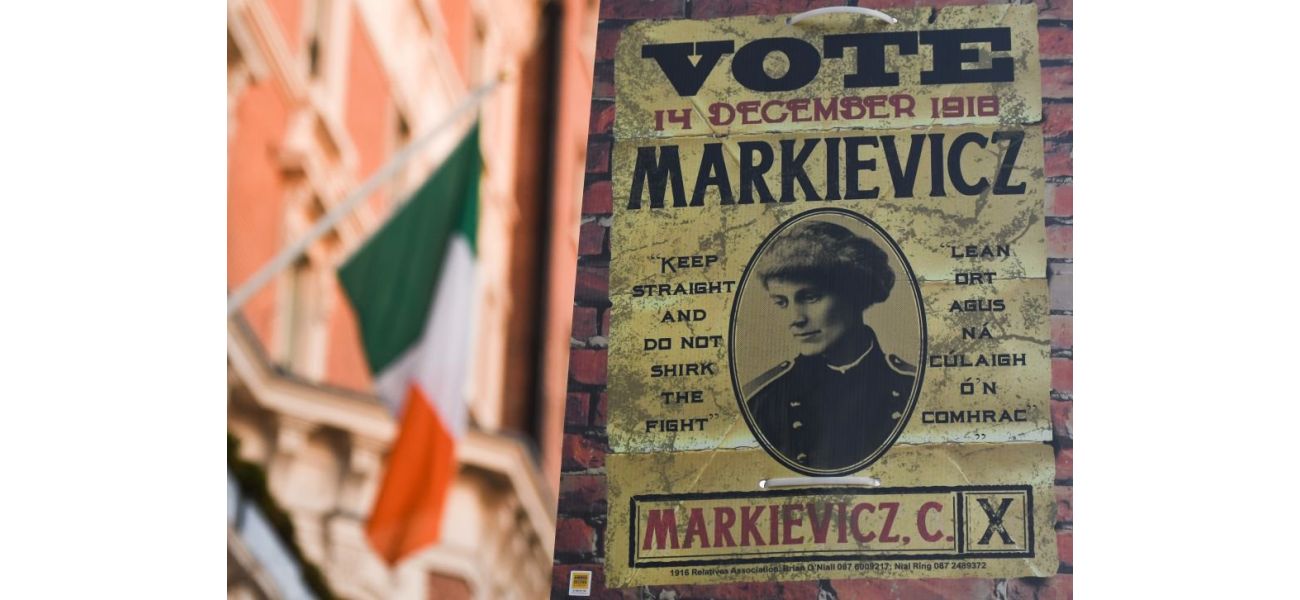The countess who made history as the first woman to be elected to UK Parliament.
106 years ago, she won the election but never took her seat in the House of Commons.
December 28th 2024.

The legacy of Constance Markievicz still casts a long shadow, especially in her home country of Ireland. If you ever find yourself wandering the halls of the Houses of Parliament, you might stumble upon a few statues and dedications to a woman by the name of Lady Nancy Astor. According to the accompanying captions, Lady Astor is known as the first female member of the House of Commons, serving as the MP for Plymouth Sutton for 26 years. However, these descriptions often seem awkwardly phrased, focusing more on the fact that she was the first woman to physically occupy a seat in the green benches. This is because Lady Astor was not actually the first woman elected to Westminster as an MP. That title belongs to someone who is not quite celebrated by the British political establishment - and who never actually took a seat.
Constance Markievicz was born in London in 1868, into a prominent Protestant family known as the Gore-Booths. Despite her privileged upbringing, she showed little interest in the high society life that was expected of her. Instead, she had a passion for art and moved to the capital to pursue her dreams. At the age of 25, she even traveled to Paris to continue her studies and eventually married a Polish count named Casimir Dunin-Markievicz. The couple then decided to settle in Dublin in 1903, where Constance quickly became a part of the city's vibrant artistic community. This community was not only known for their creativity, but also for their strong political beliefs and desire for Irish independence in the early 20th century.
Constance was often referred to as Madame Markievicz by her admirers and within five years of moving to Dublin, she became a prominent figure in the fight for Irish nationalism. She joined Sinn Féin and the militant women's movement Inghinidhe na hÉireann, and even founded the youth organization Na Fianna Éireann. Around the same time, she amicably split from her husband. As World War I raged on, Constance's fervor for the cause only grew stronger. She was known for wearing military uniforms and carrying weapons while giving her passionate speeches.
In 1916, during the Easter Rising, Constance served as second-in-command at St. Stephen's Green in Dublin. After a week of intense fighting, she and her fellow fighters were forced to surrender and were subsequently arrested. Constance was initially sentenced to death, but due to her gender, this was later commuted to a life sentence. After 14 months in prison, she was released under a general amnesty, only to be detained again shortly afterwards.
It was in 1918, during the first election in which women were allowed to vote, that Constance made history in British politics. She was voted as the Member of Parliament for Dublin St. Patrick's, with the results being announced on December 28 while she was still incarcerated in London's Holloway Prison. In line with Sinn Féin's beliefs, Constance did not take her seat in the House of Commons. Instead, she joined the First Dáil, an alternative Parliament set up by Sinn Féin in Dublin. She was even named Ireland's first Minister for Labour, making her one of the first female government ministers in Europe. Despite spending much of her time in prison, Constance held this role for two and a half years before stepping down in protest against the Anglo-Irish Treaty of 1922.
Unfortunately, Constance's dream of an independent Ireland also meant that she was the last MP for Dublin St. Patrick's, as the constituency was abolished. However, her opposition to the terms of the independence she fought for dictated the rest of her political career. In 1926, she joined Fianna Fáil and was successfully voted in as a TD for Dublin South in the June 1927 general election. However, years of tireless work had taken a toll on her health, and she passed away at the young age of 50, just one month after being elected.
Constance Markievicz lived a short but impactful life, playing many roles such as artist, aristocrat, and activist. It wasn't until 2018, 90 years after her death, that her trailblazing status in British politics was finally recognized. The Irish Parliament gifted a stately portrait of Constance to the UK Parliament, cementing her mark upon it. It's impossible to know how she would feel about being honored by an institution she fought against her entire adult life, but her undeniable impact on British history cannot be ignored.
Constance Markievicz was born in London in 1868, into a prominent Protestant family known as the Gore-Booths. Despite her privileged upbringing, she showed little interest in the high society life that was expected of her. Instead, she had a passion for art and moved to the capital to pursue her dreams. At the age of 25, she even traveled to Paris to continue her studies and eventually married a Polish count named Casimir Dunin-Markievicz. The couple then decided to settle in Dublin in 1903, where Constance quickly became a part of the city's vibrant artistic community. This community was not only known for their creativity, but also for their strong political beliefs and desire for Irish independence in the early 20th century.
Constance was often referred to as Madame Markievicz by her admirers and within five years of moving to Dublin, she became a prominent figure in the fight for Irish nationalism. She joined Sinn Féin and the militant women's movement Inghinidhe na hÉireann, and even founded the youth organization Na Fianna Éireann. Around the same time, she amicably split from her husband. As World War I raged on, Constance's fervor for the cause only grew stronger. She was known for wearing military uniforms and carrying weapons while giving her passionate speeches.
In 1916, during the Easter Rising, Constance served as second-in-command at St. Stephen's Green in Dublin. After a week of intense fighting, she and her fellow fighters were forced to surrender and were subsequently arrested. Constance was initially sentenced to death, but due to her gender, this was later commuted to a life sentence. After 14 months in prison, she was released under a general amnesty, only to be detained again shortly afterwards.
It was in 1918, during the first election in which women were allowed to vote, that Constance made history in British politics. She was voted as the Member of Parliament for Dublin St. Patrick's, with the results being announced on December 28 while she was still incarcerated in London's Holloway Prison. In line with Sinn Féin's beliefs, Constance did not take her seat in the House of Commons. Instead, she joined the First Dáil, an alternative Parliament set up by Sinn Féin in Dublin. She was even named Ireland's first Minister for Labour, making her one of the first female government ministers in Europe. Despite spending much of her time in prison, Constance held this role for two and a half years before stepping down in protest against the Anglo-Irish Treaty of 1922.
Unfortunately, Constance's dream of an independent Ireland also meant that she was the last MP for Dublin St. Patrick's, as the constituency was abolished. However, her opposition to the terms of the independence she fought for dictated the rest of her political career. In 1926, she joined Fianna Fáil and was successfully voted in as a TD for Dublin South in the June 1927 general election. However, years of tireless work had taken a toll on her health, and she passed away at the young age of 50, just one month after being elected.
Constance Markievicz lived a short but impactful life, playing many roles such as artist, aristocrat, and activist. It wasn't until 2018, 90 years after her death, that her trailblazing status in British politics was finally recognized. The Irish Parliament gifted a stately portrait of Constance to the UK Parliament, cementing her mark upon it. It's impossible to know how she would feel about being honored by an institution she fought against her entire adult life, but her undeniable impact on British history cannot be ignored.
[This article has been trending online recently and has been generated with AI. Your feed is customized.]
[Generative AI is experimental.]
0
0
Submit Comment





